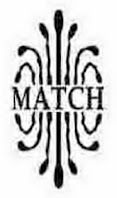The Board reversed a Section 2(d) refusal to register the mark MATCH STUDIO for "clothing, namely, tops and bottoms," finding confusion not likely with the registered marks MATCH in standard character and design form for overlapping clothing items. Applicant Garan demonstrated that the term MATCH is a weak formative in light of third-party registrations and uses, and thereby convinced the Board that the marks are distinguishable. In re Garan Services Corp., Serial No. 88674888 (November 3, 2021) [not precedential] (Opinion by Judge Marc A. Bergsman).

MERRIAM-WEBSTER DICTIONARY defines "match" as "a pair suitably associated // carpet and curtains are a match," and "to harmonize with // the jacket matched the pants." Applicant Garan also submitted 55 third-party registrations consisting, in part, of the word "match" for clothing products. Twenty of the registrations issued before registration of the cited marks.
We presume that the owner of the cited registrations did not perceive its MATCH marks as interfering with the prior-registered MATCH marks and that the owners of those prior registrations did not perceive Registrant's MATCH marks as interfering with their use of their MATCH marks. Likewise, we presume that Registrant and the other owners of the prior MATCH registrations did not have a problem with the registration of the third-party marks issued after the registration of the Registrant's marks.
More than a dozen third-party websites used the word "match" as part of a trademark in connection with the sale of clothing. These websites "show that others in the clothing field consider the word 'match' to have a highly suggestive significance when applied to clothing (i.e., that clothing products should complement or enhance each other)."
Under these circumstances, based on the evidence of record, we accord marks consisting, in whole or in part, of the word "match" in connection with clothing a narrow scope of protection. Such marks, inherently, are highly suggestive; in the marketplace, such marks travel in a crowded field. In other words, Registrant's MATCH marks are not entitled to such a broad scope of protection that they will bar the registration of every mark comprising, in whole or in part, the word "match"; they will only bar the registration of marks "as to which the resemblance to [Registrant's marks] is striking enough to cause one seeing it to assume that there is some connection, association or sponsorship between the two."
Turning to the marks, the Board focused on the mark MATCH in standard form, the Board disagreed with the examining attorney's contention that MATCH is the dominant element in Applicant Garan's mark. "We find that, although MATCH is the entirety of the commercial impression created by Registrant's mark, in Applicant's mark the words 'match' and 'studio' have equal weight in creating the commercial impression. This is because, as discussed above, we found the word 'match' to be highly suggestive as applied to clothing."
The Board concluded that the inclusion of the word "studio" in Garan's mark sufficed to distinguish the two marks when considered in their entireties. And so, the Board reversed the refusal to register.
TTABlogger comment: Sometimes the only way to overcome a 2(d) refusal is via a "crowded field" and "weak formative" argument, relying on Jack Wolfskin and Juice Generation. This case shows how to do it.
The content of this article is intended to provide a general guide to the subject matter. Specialist advice should be sought about your specific circumstances.
